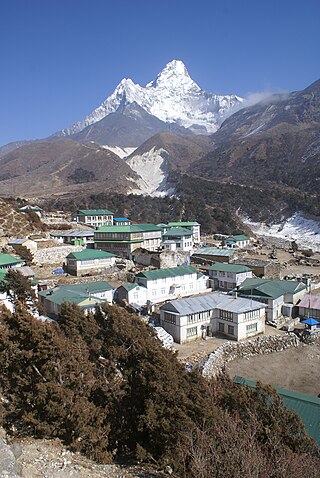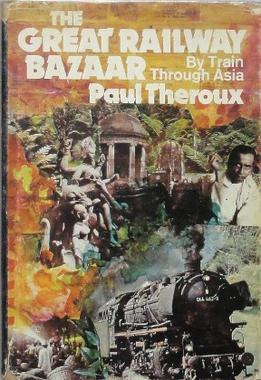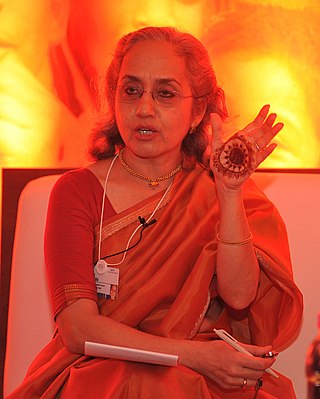
A bazaar or souk is a marketplace consisting of multiple small stalls or shops, especially in the Middle East, the Balkans, Central Asia, North Africa and South Asia. They are traditionally located in vaulted or covered streets that have doors on each end and served as a city's central marketplace.

Sagarmāthā Zone was one of the fourteen zones of Nepal until the restructuring of zones into provinces. The headquarters of Sagarmatha is Rajbiraj. Sagarmāthā is a Nepali word which as per some sources, is derived from सगर and माथा.

Thyagaraya Nagar, commonly known as T. Nagar, and historically known as East Mambalam, is a very affluent commercial and residential neighbourhood in Chennai, Tamil Nadu, India. It is surrounded by Nungambakkam in the North, Teynampet in the East, Nandanam in the South-East, C.I.T. Nagar in the South and West Mambalam and Kodambakkam in the West. The stretch between Duraiswamy Road and T. Nagar Bus Stand has some of the costliest real estates in Chennai. It was constructed between 1923 and 1925 by the Madras Presidency government of the Raja of Panagal as a part of town planning activities initiated according to the Madras Town Planning Act of 1920. The town was named after P. Thyagaraya Chetty. The streets, parks and localities in the new neighbourhood were named after important officials in the provincial government.

Old Delhi is an area in the Central Delhi district of Delhi, India. It was founded as a walled city and officially named Shahjahanabad in 1648, when Shah Jahan decided to shift the Mughal capital from Agra. The construction of the city was completed in 1648, and it remained the capital of Mughal India until its fall in 1857, when the British Empire took over as paramount power in the Indian subcontinent.

Peter Stuart Hopkirk was a British journalist, author and historian who wrote six books about the British Empire, Russia and Central Asia.

Sowcarpet is a neighborhood in the northern part of Chennai, India. Sowcarpet is one of the oldest neighborhoods of the city with narrow streets and vintage buildings. It is a bustling commercial area of the city, and a range of wholesale markets are located here. The locality is known as the North Indian hub of Chennai owing to the presence of the North Indian community here. Sowcarpet is home to the largest Marwadi community in South India.

Chetan Bhagat is an Indian author, columnist, screenwriter and YouTuber. He was listed in Time magazine's list of World's 100 Most Influential People in 2010. Bhagat has produced many novels, with several of these works turned into movies, such as One Night @ the Call Center and Half Girlfriend.

Tiretta Bazaar, also known as Chinatown, is a neighborhood near Lalbazar in Central Kolkata. It is usually called Old China Market. The locality was once home to 20,000 ethnic Chinese Indian nationals, but now the population has dropped to approximately 2,000. Most of the Hakka Chinese people in the area moved closer to Tangra. The traditional occupation of the Chinese Indian community in Kolkata had been working in the nearby tanning industry as well as in Chinese restaurants. The area is still noted for the Chinese restaurants where many people flock to taste traditional Chinese and Indian Chinese cuisine.

The Great Railway Bazaar: By Train Through Asia is a travelogue by American novelist Paul Theroux, first published in 1975. It recounts Theroux's four-month journey by train in 1973 from London through Europe, the Middle East, the Indian subcontinent and Southeast Asia, and his return via the Trans-Siberian Railway. The first part of the route, to India, followed what was then known as the hippie trail. It is widely regarded as a classic in the genre of travel writing. It sold 1.5 million copies upon release.

Jon Lee Anderson is an American biographer, author, investigative reporter, war correspondent, and staff writer for The New Yorker, reporting from war zones such as Afghanistan, Iraq, Uganda, Palestine, El Salvador, Ireland, Lebanon, Iran, and throughout the Middle East as well as during Hurricane Katrina rescue efforts with K38 Water Safety as documented in the New Yorker article Leaving Desire. Anderson has also written for The New York Times, Harper's, Life, and The Nation. Anderson has profiled political leaders such as Hugo Chávez, Fidel Castro, Che Guevara, and Augusto Pinochet.
Premankur Atorthy (1890–1964) was an Indian novelist, journalist, and film director. He was involved in Hindi and Bengali cinema.

Mamang Dai is an Indian poet, novelist and journalist based in Itanagar, Arunachal Pradesh. She received Sahitya Akademi Award in 2017 for her novel The Black Hill.
Kishore Biyani is an Indian businessman who is the Founder & CEO of Future Group, one of India's biggest brick-and-mortar retailers. He is also the founder of retail businesses such as Pantaloon Retail and Big Bazaar.

Rajni Bakshi is a Mumbai-based freelance journalist and author. She writes about social and political movements in contemporary India. Rajni is the founder and curator of Ahimsa Conversations, an online platform for exploring the possibilities of nonviolence.
Dwight Garner is an American journalist and longtime writer and editor for The New York Times. In 2008, he was named a book critic for the newspaper. He is the author of Garner's Quotations: A Modern Miscellany and Read Me: A Century of Classic American Book Advertisements. In 2023 he published his memoir, The Upstairs Delicatessen: On Eating, Reading, Reading About Eating, and Eating While Reading.

Kai Po Che!: Brothers... For Life is a 2013 Indian Hindi-language buddy sports drama film directed by Abhishek Kapoor and produced by Ronnie Screwvala and Siddharth Roy Kapur under UTV Motion Pictures, marking the banner's first solo production under the Disney·UTV brand. Adapted from Chetan Bhagat's 2008 novel The 3 Mistakes of My Life, with a three-song soundtrack by Amit Trivedi and lyrics by Swanand Kirkire, the film stars Rajkummar Rao, Amit Sadh, and newcomer Sushant Singh Rajput as the three main protagonists while Amrita Puri plays the female lead. The title is originally a Gujarati phrase that means "I have cut" which refers to Makar Sankranti where one of the competitors uses his kite to cut off another competitor's kite and yells the phrase.

Kishalay Bhattacharjee is an Indian, senior journalist, columnist and author.
Mayang is a term used by the Manipuri in Manipur to refer to non-Manipuri Indians, especially the speakers of Hindustani language and Bengali people But historically the term has been used to denote the Bishnupriya Manipuris and Bengalis, who are considered by Meiteis to be outsiders in Manipur. The term was later casually used to denote 'foreigner' during the militancy in Manipur, which effectively translated to Indians from outside the state. Indians in general and Bengalis in particular became the targets of attacks. According to journalist Kishalay Bhattacharjee, the term is synonymous to Dkhar in Meghalaya.

Meitei nationalism refers to nationalism among the Meitei people. In the Meitei context this includes various movements throughout history to sustain Meitei cultural identity, political boundary, ethnicity and history to regain sovereign state status of Kangleipak.

Marjing is the God of horses, polo, hockey, sports and war in Sanamahism, the indigenous religion of Manipur. The guardianship of the north eastern direction is alluded to Marjing and the other directions to Koupalu, Thangching and Wangpulen. According to the legend, he invented the game of polo and introduced it as the national game. He and his divine creature, Samadon Ayangba, reside in the top of the Heingang Ching.
















